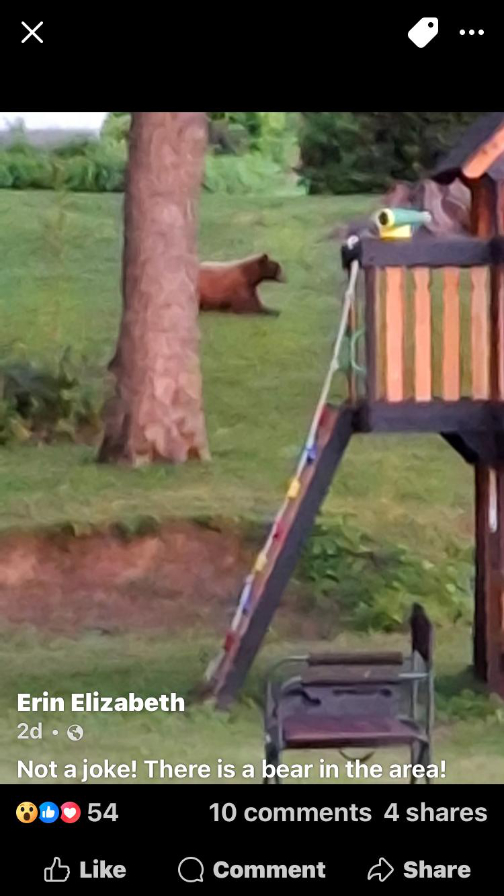STE. GENEVIEVE – Recent social media reports of a bear sighting in Ste. Genevieve County near the south Ste Genevieve city limits remind us of the steps to take when we see a bear in the neighborhood.
A resident posted this on Facebook along with a photo of the bear.
“ It was in Valle Spring. If you live by Woodhaven, Quarry town or in the area, get your kids or animals in the house. There was a large brown bear in the yard!”

First thing, after insuring your safety and the safety of family members and pers, would be to report the sighting to the Missouri Department of Conservation.
In this area, the local Conservation Office is Rob Sulkowski. He can be contacted by calling Central Dispatch at 573-883-5215. His contact information is also available on the Missouri Department of Conservation website.
How to report a bear sighting
Think you’ve spotted a bear in your part of Missouri? Please send us details of your sighting.
Although black bears are native to Missouri, they were nearly wiped out during settlement. Now they’re making a comeback and expanding their range within the state. Use the below form to report a bear sighting and remember to Be Bear Aware while in bear country.
Black bear attacks are extremely rare. If you follow these precautions, you probably won’t have any trouble with bears.
If a bear appears to be stalking, following at very close distances, or cannot be deterred, leave the area immediately (do not run) and contact your local conservation agent. If a bear makes contact, fight back aggressively using rocks, sticks, or your fists. Black bears are usually intimidated by an aggressive counterattack.
Fatal black bear attacks are more likely to be the result of predatory behavior rather than a female defending cubs.
Bears are attracted by the aroma of food. Feed pets indoors if possible. Make sure trash containers are secure. There are containers which are “bear resistant” so if the visits become commonplace, it might be a good idea to invest in these containers.
If you are hiking in bear country, even if on your own property (the bear doesn’t know if it is trespassing). Normal trail noise should alert bears to your presence and prompt a bear to leave before you ever see it. Bears usually run and hide from people.
- If possible, travel in groups of three or more people. Typically, larger groups of people make more noise and appear more formidable to bears. Keep your group together and make sure children are close to you at all times.
- Use caution in areas like berry patches where bears are likely to venture for food.
- Never approach a bear — observe it only from a distance. If you encounter a bear at close range, remain standing upright, try to look as large as possible, avoid direct eye contact, back up slowly, and speak in a calm and assertive voice.
- Carry bear spray — but knowhow to use it. Bear spray is extremely effective to deter bear attacks. Bear spray is a non-toxic and non-lethal means of warding off aggressive bears that temporarily affects the bear’s respiratory system and mucous membranes. Keep bear spray immediately available on your belt or your pack’s waist strap, not inside your pack. Use only bear spray — self-defense spray meant for humans is not effective.
- If a bear approaches while you are eating, put food away and slowly retreat a safe distance. Never abandon food because of an approaching bear. Always take food with you.
- Never throw your pack or food at a bear in an attempt to distract it.
- If a bear moves toward you or charges you, do not run!
- Some bears will bluff their way out of a threatening situation by charging but will swerve off or stop suddenly before reaching you. Bear experts generally recommend standing still until the bear stops and then slowly backing away. Use bear spray if you have it.
